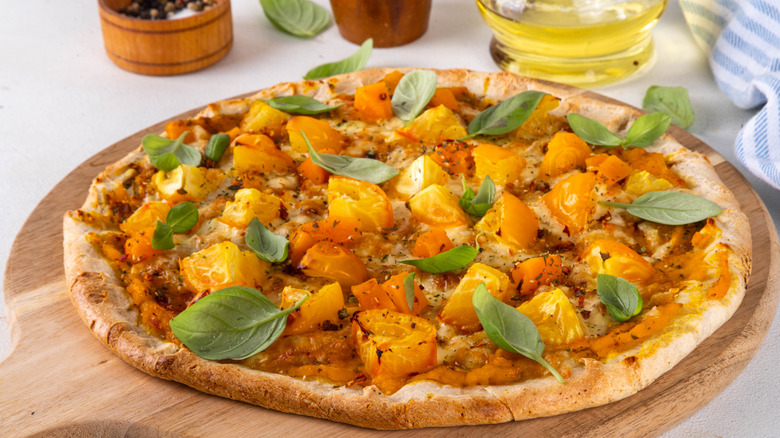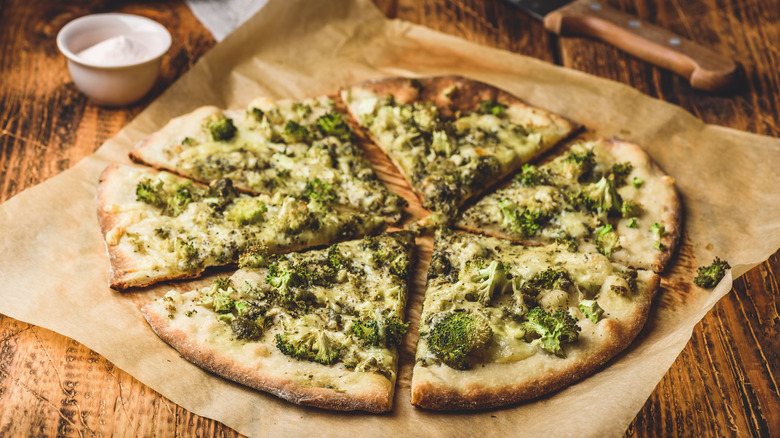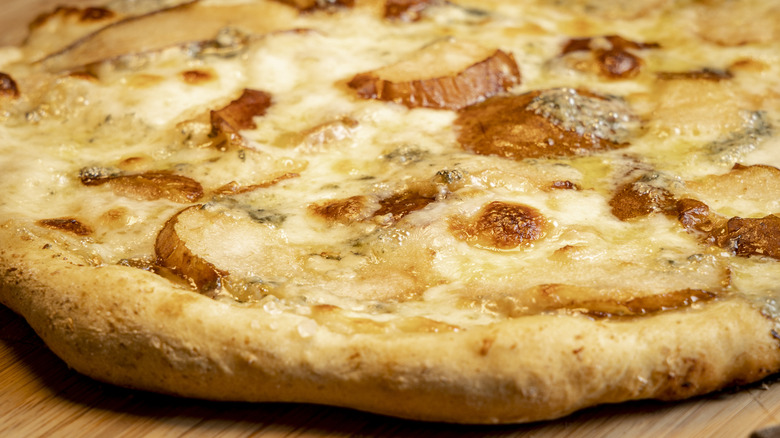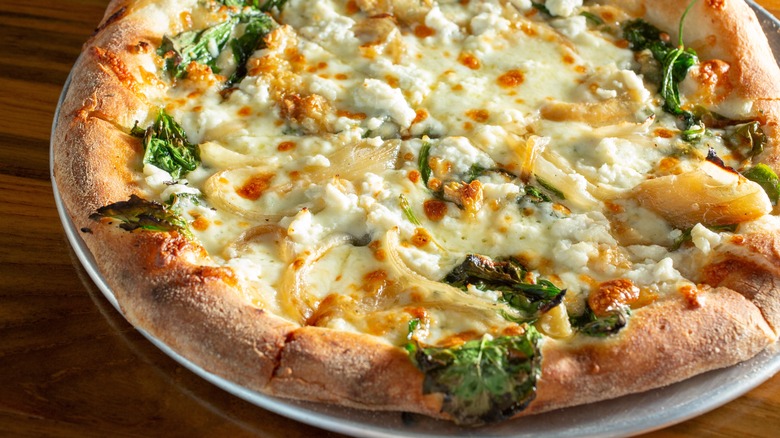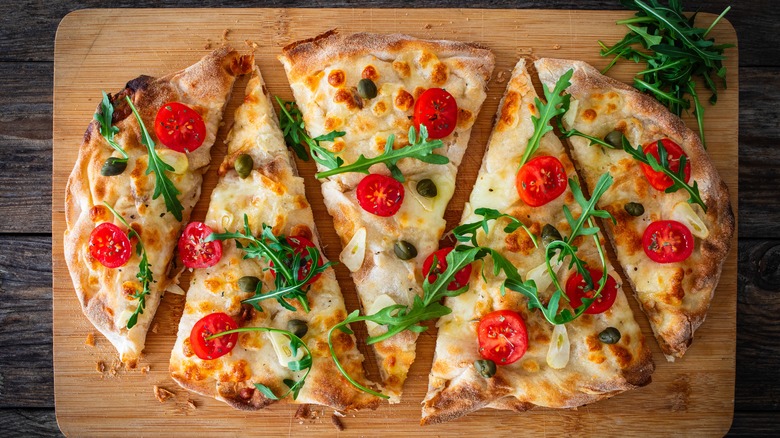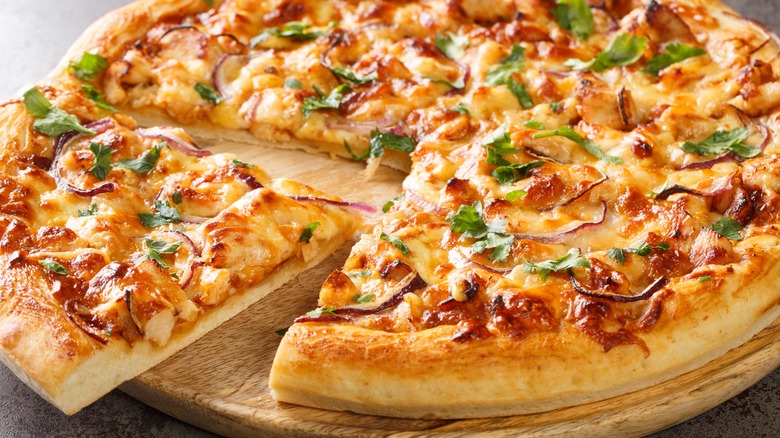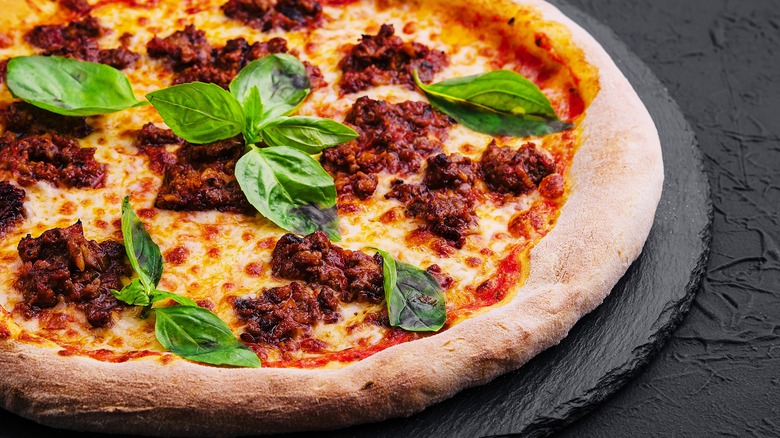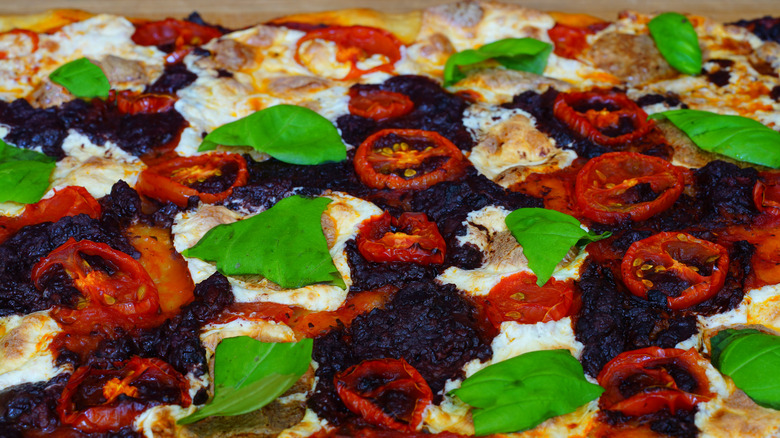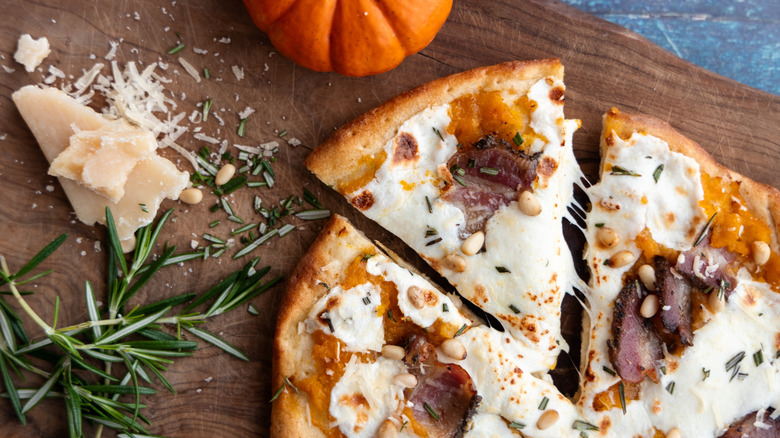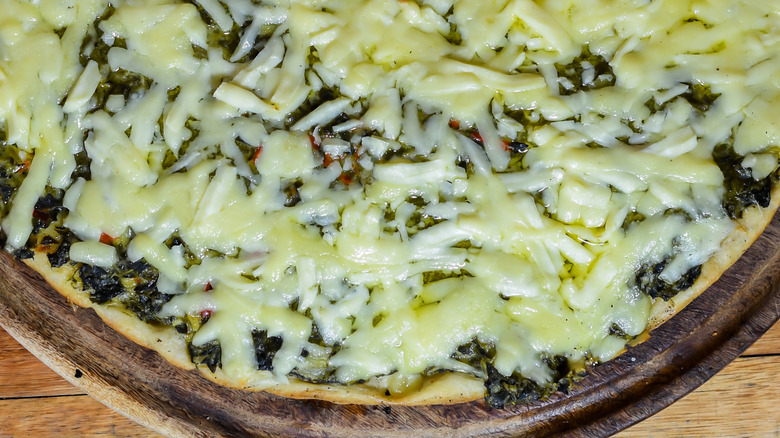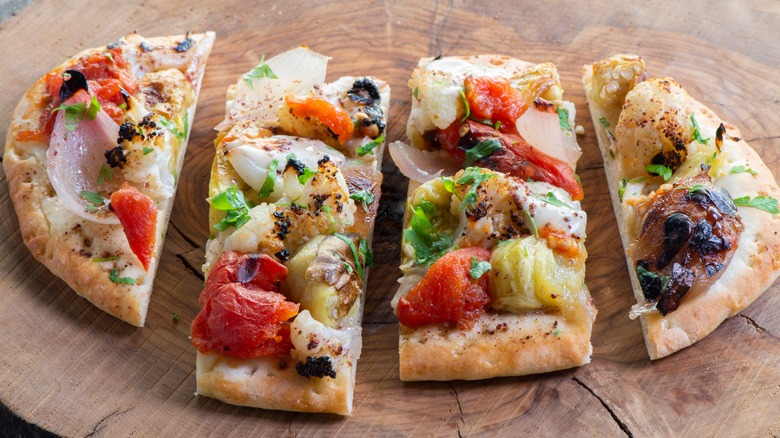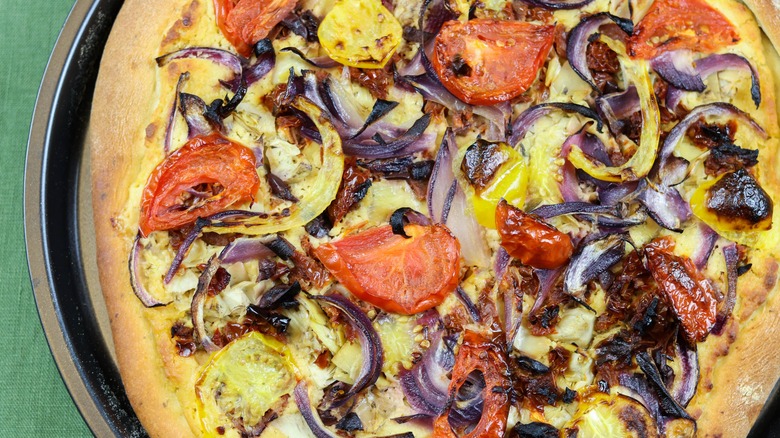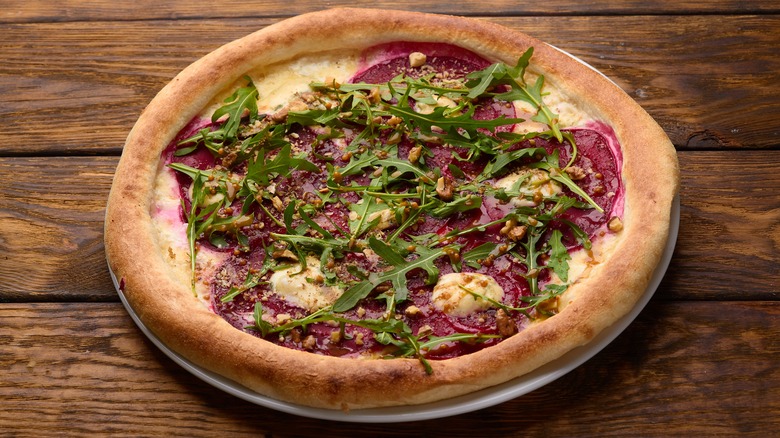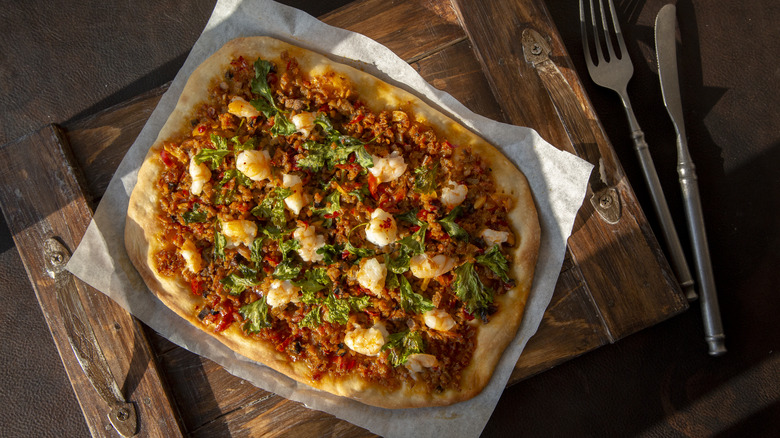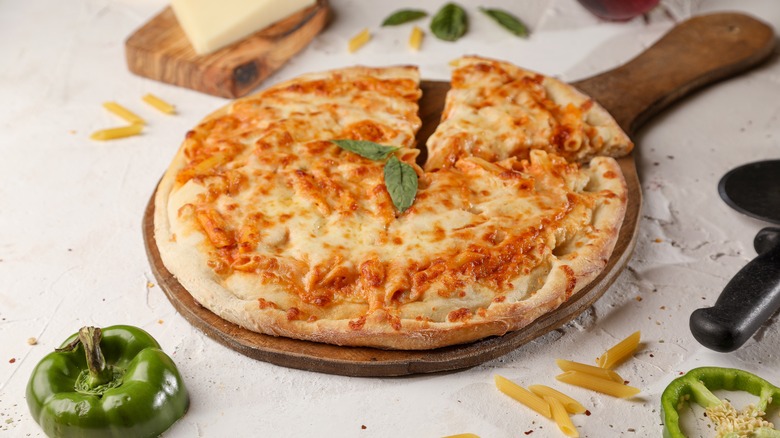14 Pizza Sauces Beyond Tomato You'll Wish You Tried Sooner
It's a rare individual that doesn't love pizza. Still, the same old versions can get boring. You've experimented with a range of toppings and you've tried out different cheese, but you remain feeling stuck in a rut. Well, how about trying out pizza sauces that go beyond the usual tomato option? This can bring a whole new flavor profile to your pizza. A Margherita pizza with mozzarella and tomato sauce tastes remarkably different from one with a pesto sauce, despite all the other ingredients being the same.
Using non-tomato sauces on pizza is a great way to experiment. It also lets you change with the seasons. For instance, a classic sauce is great made with fresh tomatoes in the late summer, at the peak of their ripeness. But when tomato season is over and fall comes around, a pumpkin sauce might be more fitting. It's also the perfect opportunity to try out varying cheeses and toppings. Mozzarella might be the normal choice for tomato-based pizzas, but cheddar might stand up better to an assertive BBQ sauce. These are 14 pizza sauces beyond tomato you'll wish you tried sooner.
Pesto
If pesto is among the pizza toppings you haven't tried, you need to change that. Like, now. Its rich herbiness is delicious on pizza. It makes an excellent sauce to replace tomato. However, it has a strong flavor, so you either need to make pesto the star of the show or use other robust ingredients to counterbalance it.
Pesto pizza is great with a creamy, mild cheese like mozzarella or ricotta. Or better yet, use both. This gives you some balance to the punchy flavor of pesto, which already has Parmesan or pecorino in it. Using another strong cheese can be too much. Fresh cherry tomatoes make a great topping, bringing a pop or fresh brightness that offsets the bold flavor.
You can find ready-made pesto at practically any grocery store. However, it's also easy to make yourself — and even more delicious when you do. Classic pesto contains basil, pine nuts, Italian hard cheese, and plenty of quality extra-virgin olive oil, but there are many alternatives. You can make wild garlic pesto, arugula pesto, red pesto with sun dried tomatoes, and so many more options. Instead of pine nuts, you can use any other nut of your choice. You can even make it vegan by removing the cheese. It's a versatile choice to use as a pizza sauce.
White sauce
White sauce on pizza isn't a new concept but it's a delicious one. It makes pizzas intensely rich and creamy. Some people might miss the juxtaposition between sweet, slightly tart tomato sauce and creamy mozzarella. However, if you're ready to lean into the heavy lusciousness of it, you're in for a treat.
White sauce is the same as béchamel. It's made with butter, flour, milk, and seasonings. To make it, you first melt the butter in a saucepan, then add flour to make a roux. After cooking the roux for a couple of minutes to toast it, you gradually add milk, whisking the mixture to form a smooth sauce. You may need to use slightly less milk than you would if you were making a béchamel sauce for a pasta dish or casserole, since it needs to stay on the pizza base without dripping off.
You can also make variations on a classic béchamel. For instance, like this roasted garlic white pizza sauce recipe. It adds roasted garlic, herbs, and Parmesan, deepening the flavors and making them more complex. It works brilliantly on pizza. White sauces pair well with fresh ingredients that add some brightness, such as figs, chili jam, broccoli, or a handful or arugula, added after you remove the pizza from the oven.
Ricotta
Ricotta cheese makes an excellent base for pizza. It gives the dish a creamy, mild foundation that lets other flavors shine. It's a great alternative sauce for white pizza if you don't want to go to the trouble of making a béchamel sauce. Slather it on your pizza dough and build the rest from there.
We love that ricotta is versatile enough to work with all kinds of toppings. Fresh vegetables work well. Sautéed mushrooms, caramelized onions, wilted spinach — they're all delicious with ricotta as your sauce. Roasted garlic adds depth of flavor without overpowering delicate ricotta.
You don't need to skip other cheeses just because you're using ricotta. Add small amounts of mozzarella for its stretch, or sprinkle some Parmesan for sharper salty notes. Fontina melts beautifully and adds a nutty flavor that complements ricotta. Fresh herbs elevate a ricotta base pizza. Try fresh basil, thyme, or oregano. Add soft herbs raw after cooking, while woody ones can be cooked on the pie. A drizzle of olive oil before serving brings everything together. You should keep the toppings light, as ricotta pizza works best when it's not overloaded. This way you can appreciate the subtle flavors of every ingredient. It's even better if you season your ricotta with a pinch of salt and some cracked black pepper before spreading it on the dough.
Olive oil and garlic
Another alternative for a white pizza is simply using olive oil and garlic in place of a conventional sauce. This tastes good and keeps the dough from drying out without asserting an overwhelming flavor. It lets you showcase the other ingredients or make a simple pizza. For instance, top your dough with olive oil, garlic, and cheese and you effectively have a pizza-shaped cheesy garlic bread — delicious.
The great thing about this base is how easy it is. To prepare it, you only need the time it takes to dice some garlic and drizzle some olive oil. You can adjust it depending on how garlicky you like your food. For instance, a single small clove of garlic will suffice for one pizza if you like it mild. You could also use a couple of large cloves for a more robust garlic flavor. Or if you prefer the mild flavor of roasted garlic, you can mash a whole bulb and mix it with olive oil. Adding some herbs doesn't go amiss, either.
Because this is somewhat of a blank canvas, you can pair it with practically any cheese or toppings. However, it's a good chance to use ingredients with delicate flavors that might not stand up well to a heavy tomato sauce. For instance, a garlic base is great with pears and Camembert or king oyster mushrooms.
BBQ sauce
BBQ sauce in place of tomato sauce on pizza is somewhat divisive. Some people love it, while others think it's a travesty akin to pineapple on pizza. Sure, you won't find it on authentic Italian menus, but we think it has a place. After all, experimenting with non-tomato pizza sauce is all about trying new things.
BBQ chicken pizza recipes are common, but not your only option. Think about other flavors that go with BBQ sauce. Pulled pork works well — or pulled jackfruit as a vegetarian option. Other slightly sweet toppings work well on a BBQ sauce base, such as bell peppers, Roquito peppers — and we hate to say it — but also pineapple. Ingredients with some umami richness also work well to balance out the sweetness. Think aged cheeses, olives, and mushrooms.
You can use store-bought BBQ sauce or make your own. Ready-made sauces are the simpler choice, but homemade ones taste amazing and are easier to whip up from scratch than you might imagine.
Romesco sauce
If you don't know what romesco sauce is and what it tastes like, you're about to discover something incredible. Hailing from the region of Catalonia in Spain, this sauce uses everyday ingredients but turns out remarkably tasty. And the flavors are so well-suited to pizza that it's surprising it isn't used as a sauce for it more often.
Romesco sauce as made in the U.S. contains roasted red bell peppers and roasted tomatoes, almonds, garlic, bread, olive oil, and red wine vinegar. However, in Spain, dried ñora peppers are used in place of the bell peppers. It's adaptable, though, so you can also use other nuts or leave out the bread.
The resulting sauce is thick, flavorful, and surprisingly creamy. It's absolutely delicious as a pizza sauce. It has a familiar slightly tomatoey flavor but the other ingredients mean it's far from a conventional pizza sauce. You can pair it with pretty much any kind of cheese, from a mild mozzarella to a strong blue cheese. Throwing a Spanish cheese like Manchego in the mix would be fitting. It also works well with basically any toppings, though we'd recommend trying it with sliced potato.
Olive tapenade
Olive tapenade brings its intense flavor to pizza as a tasty alternative to traditional tomato sauce. You can find it in stores or follow a tapenade recipe to make your own by blending olives with other ingredients such as garlic, capers, and herbs. Either way, spread it thinly because tapenade packs a punch.
This bold base is great with Mediterranean toppings. You could add roasted red peppers, artichoke hearts, or sun-dried tomatoes. Fresh vegetables like thinly sliced zucchini or eggplant work well, too. For protein, consider grilled chicken, white beans, anchovies, or Italian sausage.
When it comes to cheese, you should stick to varieties that stand up to the strong olive flavor. The salty tanginess of fate makes it a good choice, while mild mozzarella or ricotta provide contrast. Goat cheese works nicely, too. Just don't use too much of any salty cheeses, as tapenade is also salty. You can finish off the pie with some fresh herbs. Scatter basil leaves after baking, or try oregano or thyme baked with the pizza.
Pumpkin sauce
Nothing says fall like a pumpkin sauce pizza. There's no better way to embrace spooky season. But these types of squash are in season all through the winter, so there's plenty of time to try it.
It's simple to make a winter squash sauce. You just need to blend roasted squash with aromatics, such as cooked onion and garlic, or herbs like sage or thyme. You can also use canned pumpkin purée if you're in a hurry, but we prefer the complex flavor of whole squash. Plus, it gives you the opportunity to experiment with different varieties. For instance, you could use red kuri squash for its intense nutty flavor or delicata squash for its milder sweetness.
Pumpkin is a fairly delicate flavor, so this pizza is best kept simple so it's not overwhelmed. Top it with a mild cheese, like mozzarella, provolone, ricotta, or fontina. Then add some whole sage leaves to get crispy as the pizza cooks. Maybe a little olive oil drizzled over the pizza when it's out of the oven and you're good to go.
Chimichurri sauce
Chimichurri sauce is packed with herbs and olive oil — making it a similar choice to pesto. But the difference is that it uses fresh parsley and forgoes any kind of nuts or cheese. This makes it a little more liquid than an average pesto. Even so, it makes a great base for pizza in place of tomato sauce.
It's brighter and zestier than pesto, using lemon juice and vinegar. It's a little less intense and doesn't steal the show. This means it can be paired on pizza with bold cheeses and heavy ingredients without the finished dish becoming too much. It works with steak, goat cheese, figs, artichoke, and olives. And that's just the tip of the iceberg. It's versatile enough to try with most cheeses and toppings.
Unlike pesto, it isn't often found ready-made. Instead, you'll have to find a chimichurri sauce recipe. The easiest versions simply involve sticking all the ingredients in a blender or food processor and hitting the pulse button. However, more authentic recipes call for chopping the ingredients by hand.
Tahini sauce
And now for something completely different. Tahini sauce might not seem like the obvious choice for pizza. It certainly isn't traditional, but don't let that stop you. If you think of pizza as a flatbread, it absolutely makes sense. You might just need to adjust the toppings you use.
First off, you might be wondering what tahini is and how you use it. It's a paste made from sesame seeds that's perhaps best-known for its supporting role in hummus. However, you can also mix it with water and other ingredients like salt, garlic, and olive oil to make tahini sauce. It's this less intense version that we suggest you put on pizza in place of tomato sauce, not tahini straight from the jar, which would be overly thick and cloying.
When you use tahini sauce on pizza, you need to rethink the toppings. Veggies like grilled or roasted eggplant or zucchini work well, as do olives and Middle Eastern pickles. Most cheeses won't taste great with tahini, but you could use labneh, halloumi, feta, or similar. Finish the pizza with fresh herbs, such as parsley, mint, and cilantro, when it comes out of the oven.
Hummus
Hummus is another Middle Eastern-inspired alternative to tomato sauce on pizza. It doesn't overpower other ingredients, making it a good base for a range of flavors — however, it certainly doesn't work with everything. Don't expect classic pizza flavors but embrace something different.
When using hummus on pizza, consider topping it with Mediterranean or Middle Eastern ingredients. Try vegetables like roasted red peppers, artichokes, spinach, and olives. Red onion and sliced garlic add a bit of a punch. If you want to go out, you could add some quality falafel as a topping.
Fresh herbs like mint, parsley, or cilantro pair nicely, though you should add them after the pizza's done cooking. You might also want to throw some fresh arugula on top. Cheese is optional here, but labneh, feta, or goat cheese work well. They add a tang that complements hummus.
There are countless brands of hummus you can buy at the store, but creamy ones work especially well. Of course, you can also make your own from scratch. It only takes a few minutes and it's often better than store-bought varieties.
Beet purée
Beets and pizza might not be the first combination that you'd think about putting together. But stick with us when we say that beet purée works well on pizza. This is one collab worth shouting about. The sweet earthy notes of beet bring a complexity to the dish. It works especially well with sharp or strong cheeses.
You can make beet purée for pizza using pickled beets, which adds a nice tang. However, if you want to keep things slightly more mellow, you can make the sauce from scratch, roasting or simmering beets before blending them. Adding cream cheese or ricotta is nice if you want some of that beet flavor without it being overwhelming. Beet pesto is also a delicious choice for pizza. There are some store-bought options available — or you can make it by blending beets, pine nuts, garlic, and Parmesan or pecorino cheese.
On top of the beet sauce, you need a robust cheese that can assert itself. Goat cheese, blue cheese, or mature cheddar all work well. Top it with some fresh dill when it's out of the oven and you have yourself a tasty pizza.
Harissa
If you're looking to spice things up, harissa makes an excellent pizza sauce. It not only brings heat but adds a smokiness to your pie. This North African chili paste contains ingredients like red peppers, garlic, and spices such as cumin and coriander. Using it as a base sauce gives your pizza a bold kick and makes it stand out from others. You can find it in most supermarkets, often with Middle Eastern ingredients.
To balance out the spiciness, you might want to pair harissa with mild or sweet toppings. Roasted vegetables like bell peppers, zucchini, and eggplant go well. You could also add thinly sliced red onions or cherry tomatoes to bring some freshness. For cheese, go with something creamy to complement the spice. Mozzarella melts well and balances the heat, but you can also try goat cheese or ricotta for a richer taste. Feta works, too, contrasting the rest of the dish with its saltiness.
Vodka sauce
You might be familiar with creamy vodka sauce from pasta dishes. It's commonly paired with penne, but it absolutely works as a pizza sauce, too. It's similar enough to regular pizza sauce to work with classic topping combinations. However, it's sufficiently different to bring a twist to the finished pie.
This sauce consists of tomatoes and cream, cooked with a splash of vodka to enhance the other flavors. Yes, it does contain tomato, but it's not the same as a tomato pizza sauce. The cream makes it richer and less acidic and the vodka just rounds everything out. If you've been scared of it in the past, know that you don't taste the alcohol at all. It just magically accentuates the other flavors, making it extra tasty.
With vodka sauce as the base, you can enjoy classic pizza toppings in a new light. Pepperoni, four cheese, mushroom, or a simple Margherita — they're all familiar but slightly different with this delicious base. We'd recommend keeping it fairly simple because you want the sauce to be the star of the show. Or you could take it up a gear by topping your pizza with penne in vodka sauce and finishing it off with cheese. A bit like a mac and cheese pizza. Yes, it's OTT, but it's delicious.
